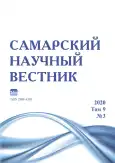Fauna and ecology of Hymenoptera background species of terrestrial ecosystems in the Yenisei Siberia tundra and forest-tundra
- Authors: Baranov A.A.1, Stambrovskaya E.V.2,1, Gorodilova S.N.1, Bannikova K.K.1, Melnik O.N.1
-
Affiliations:
- Krasnoyarsk State Pedagogical University named after V.P. Astafiev
- Chemistry and Ecology Department
- Issue: Vol 9, No 3 (2020)
- Pages: 21-27
- Section: General Biology
- URL: https://journals.rcsi.science/2309-4370/article/view/50355
- DOI: https://doi.org/10.17816/snv202093103
- ID: 50355
Cite item
Full Text
Abstract
This paper presents materials on the ecology and faunistic composition of four species of Hymenoptera: Urocerus gigas L., 1758; Vespula vulgaris L., 1758; Bombus polaris Curtis, 1835; Bombus hyperboreus Schonherr, 1809. Their number was calculated for 2017–2019, data on population density, seasonal activity and forage plants of Hymenoptera adults in the tundra and forest-tundra of Yenisei Siberia are presented. As a result of calculating in both natural conditions, numerous species are true wasps and bumblebees and the large horntail is a rare species and was recorded only in the forest-tundra. When studying the food base of the studied species, it was noted that Vespula vulgaris was most often found on the forest bellap Anthriscus sylvestris L., in thickets of willow shrubs, Salix polaris Wahlenb. Adult insects Urocerus gigas were found mainly on Siberian larch Larix sibirica L. and alder forest Alnus fruticosa Rupr. Individuals of Bombus polaris and Bombus hyperboreus were recorded on horned dandelion Taraxacum ceratophorum L., narrow-leaved fireweed Chamerion angustifolium L., common tansy Tanacetum vulgare L.
Full Text
##article.viewOnOriginalSite##About the authors
Aleksander A. Baranov
Krasnoyarsk State Pedagogical University named after V.P. Astafiev
Email: abaranov@kspu.ru
doctor of biological sciences, professor of Biology, Chemistry and Ecology Department
Russian Federation, KrasnoyarskEmilia V. Stambrovskaya
Chemistry and Ecology Department; Krasnoyarsk State Pedagogical University named after V.P. Astafiev
Author for correspondence.
Email: myosolis@list.ru
postgraduate student of Biology, Chemistry and Ecology Department
Russian Federation, KrasnoyarskSvetlana N. Gorodilova
Krasnoyarsk State Pedagogical University named after V.P. Astafiev
Email: svetochka_gorodilova@mail.ru
candidate of biological sciences, associate professor of Biology, Chemistry and Ecology Department
Russian Federation, KrasnoyarskKsenia K. Bannikova
Krasnoyarsk State Pedagogical University named after V.P. Astafiev
Email: kkvoronina@mail.kspu.ru
candidate of biological sciences, associate professor of Biology, Chemistry and Ecology Department
Russian Federation, KrasnoyarskOlga N. Melnik
Krasnoyarsk State Pedagogical University named after V.P. Astafiev
Email: larus-23@yandex.ru
candidate of biological sciences, associate professor of Biology, Chemistry and Ecology Department
Russian Federation, KrasnoyarskReferences
- Якушкин Г.Д., Кокорев Я.И., Колпащиков Л.А. Природные зоны и мир животных Таймыра. Белгород: Изд-во «ЛитКараВан», 2012. 276 с.
- Чернов Ю.И. Приспособительные особенности жизненных циклов насекомых тундровой зоны // Журнал общей биологии. 1978. Т. 39, вып. 3. С. 394–402.
- Chernov Yu.I. Diversity of the Arctic terrestrial fauna // Arctic and Alpine Diversity. Ecological Studies. Vol. 113 / eds. F.S. Chapin, Ch. Körner. Berlin–Heidelberg: Springer-Verlag. P. 79–93.
- Чернов Ю.И., Макарова О.Л., Пенев Л.Д., Хрулева О.А. Отряд жесткокрылых (Insecta, Coleoptera) в фауне Арктики. Сообщение 1. Состав фауны // Зоологический журнал. 2014. Т. 93, № 1. С. 7–44.
- Чернов Ю.И., Матвеева Н.В. Ландшафтно-зональное распределение видов арктической биоты // Успехи современной биологии. 2002. Т. 122, вып. 1. С. 26–45.
- Chernov Yu.I., Makarova O.L. Beetles (Coleoptera) in High Arctic // Back to the roots or back to the future? Towards a new synthesis between taxonomic, ecological and biogeographical approaches in carabidology: proceedings of the XIII European carabidologists meeting / eds. L. Penev, T. Erwin, T. Assman. Blagoevgrad, August 20–24, 2008. Sofia–Moscow: Pensoft Publishers. Ğ. 207–240.
- Стамбровская Э.В. Результаты полевых исследований энтомофауны наземных экосистем тундры и лесотундры Таймыра // Научный вестник Арктики. 2019. № 6. С. 32–34.
- Стамбровская Э.В., Баранов А.А. К наземной энтомофауне тундры и лесотундры Приенисейской Сибири // Современные биоэкологические исследования Средней Сибири: мат-лы науч.-практ. конф. «БИОЭКО». Красноярск, 26 апреля 2018 г. / отв. ред. Е.М. Антипова. Красноярск: Красноярский гос. пед. ун-т им. В.П. Астафьева, 2018. С. 59–61.
- Душенков В.М., Макаров К.В. Летняя полевая практика по зоологии беспозвоночных: учеб. пособие для студ. высш. пед. учеб. заведений. М.: Издательский центр «Академия», 2000. 256 с.
- Дунаев Е.А. Методы эколого-энтомологических исследований. М.: МосгорСЮН, 1997. 44 с.
- Песенко Ю.А. Принципы и методы количественного анализа в фаунистических исследованиях. М.: Наука, 1982. 287 с.
- Горностаев Г.Н. Определитель отрядов и семейств насекомых средней полосы европейской части СССР. М.: Изд-во МГУ, 1986. 118 с.
- Плавильщиков Н.Н. Определитель насекомых: краткий определитель наиболее распространенных насекомых европейской части России. М.: Топикал, 1994. 544 с.
- Мамаев Б.М. Определитель насекомых европейской части СССР: учеб. пособие для студентов биологических специальностей педагогических институтов. М.: Просвещение, 1976. 304 с.
- Храмов П. Каталог насекомых мира. 2007–2020 [Электронный ресурс] // International entomological community. – http://insecta.pro/ru/catalog.
- Поспелова Е.Б., Поспелов И.Н. Информационно-справочная система. Флора Таймыра. 2007–2020 [Электронный ресурс] // http://byrranga.ru/spec_list.htm.
- Стамбровская Э.В., Баранов А.А. Материалы по энтомофауне наземных экосистем тундры и лесотундры Приенисейской Сибири // Байкальский зоологический журнал. 2018. № 2 (23). С. 30–32.
- Таймыро-североземельская область. Физико-географическая характеристика / под ред. Р.К. Сиско. Л.: Гидрометеорологическое издательство, 1970. 374 с.
- Городилова С.Н. Биоразнообразие беспозвоночных животных Средней Сибири: учебное пособие. Красноярск: Красноярский государственный педагогический университет им. В.П. Астафьева, 2019. 282 с.
- Животный мир Республики Коми. Паукообразные и насекомые. Сыктывкар: Коми НЦ УрО РАН, 2010. 252 с.
Supplementary files












